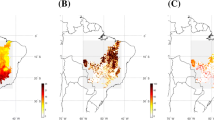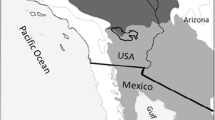Abstract
Indices that rate the vulnerability of species to climate change in a given area are increasingly used to inform conservation and climate change adaptation strategies. These species vulnerability indices (SVI) are not commonly associated with landscape features that may affect local-scale vulnerability. To do so would increase their utility by allowing managers to examine how the distributions of vulnerable species coincide with environmental features such as topography and land use, and to detect landscape-scale patterns of vulnerability across species. In this study we evaluated 15 animal species that had been scored with the USDA-Forest Service Rocky Mountain Research Station’s system for assessing vulnerability of species to climate change. We applied the vulnerability scores to each species’ respective habitat models in order to visualize the spatial patterns of cross-species vulnerability across the biologically diverse Coronado national forest, and to identify the considerations of spatially referencing such indices. Across the study extent, cross-species vulnerability was higher in higher-elevation woodlands and lower in desert scrub. The results of spatially referencing SVI scores may vary according to the species examined, the area of interest, the selection of habitat models, and the method by which cross-species vulnerability indices are created. We show that it is simple and constructive to bring species vulnerability indices into geographic space: landscape-scale patterns of vulnerability can be detected, and relevant ecological and socioeconomic contexts can be taken into account, allowing for more robust conservation and management strategies.





Similar content being viewed by others
Abbreviations
- CSVI:
-
Cross-species vulnerability index
- EMA:
-
Ecological management area
- HDMS:
-
Arizona natural heritage program: heritage data management system
- IPCC:
-
Intergovernmental program on climate change
- SAVS:
-
System for assessing vulnerability of species to climate change
- SVI:
-
Species vulnerability index
- SWReGAP:
-
Southwest regional GAP analysis program
- USA:
-
United States of America
- USDA-FS:
-
United States Department of Agriculture-Forest Service
- USFWS:
-
United States Fish and Wildlife Service
- USGS:
-
United States Geological Survey
References
ArcGIS Workstation (2010) (version 10.0.1) [software]. Redlands, CA
Bagne KE, Friggens MM, Finch DM (2011) A system for assessing vulnerability of species (SAVS) to climate change. General Technical Report RMRS-GTR-257. Fort Collins, CO: U.S. Department of Agriculture, Forest Service, Rocky Mountain Research Station
Beale CM, Lennon JJ, Yearsley JM, Brewer MJ, Elston DA (2010) Regression analysis of spatial data. Ecol Lett 13:246–264
Boykin KG, Thompson BC, Deitner RA, Schrupp D, Bradford D, O’Brien L, Drost C, Propeck-Gray S, Rieth W, Thomas K, Kepner W, Lowry J, Cross C, Jones B, Hamer T, Mettenbrink C, Oakes KJ, Prior-Magee J, Schulz K, Wynne JJ, King C, Puttere J, Schrader S, Schwenke Z (2007) Predicted animal habitat distributions and species richness. In: Prior-Magee JS et al. (eds) Southwest regional gap analysis final report, Moscow
Coe SJ, Finch DM, Friggens MM (2011) An assessment of climate change and vulnerability of wildlife in the Sky Islands of the southwest. General Technical Report RMRS-GTR-XXX. Fort Collins, CO: U.S. Department of Agriculture, Forest Service, Rocky Mountain Research Station
Davison JE, Breshears DD, Van Leeuwen WJD, Casady GM (2010) Remotely sensed vegetation phenology and productivity along a climatic gradient: on the value of incorporating the dimension of woody plant cover. Global Ecol Biogeogr 101–113
Ernst AE, Schrader S, Lopez V, Prior-Magee J, Boykin KG, Schrupp D, O’Brien L, Kepner W, Thomas K, Lowry J, Thompson B (2007) Land stewardship. In: Prior-Magee JS (ed) Soutwest regional gap analysis final report, Moscow: U.S. Geological Survey, Gap Analysis
Farrar DE, Glauber RR (1967) Multicollinearity in regression analysis—problem revisited. Rev Econ Stat 49:92–107
Hannah L, Midgley GF, Millar D (2002) Climate change-integrated conservation strategies. Global Ecol Biogeogr 485–495
HDMS (2009) Arizona’s natural heritage program species lists. Arizona Game and Fish Department, Phoenix
Heikkinen RK, Luoto M, Araujo MB, Virkkala R, Thuiller W, Sykes MT (2006) Methods and uncertainties in bioclimatic envelope modelling under climate change. Prog Phys Geogr 30:751–777
IPCC (2007) Climate change 2007: the physical science basis, contribution of working group (WG) 1 to the fourth assessment report of the IPCC (AR4). Cambridge University Press, New York
JMP (2010) (version 9.0) [software]. Cary, North Carolina
LANDFIRE (2008) The national map LANDFIRE: LANDFIRE national existing vegetation cover layer. U.S. Department of Interior, Geological Survey
Lowry J, Ramsey RD, Thomas K, Schrupp D, Sajwaj T, Kirby J, Waller E, Schrader S, Falzarano S, Langs L, Manis G, Wallace C, Schulz K, Comer P, Pohs K, Rieth W, Velasquez C, Wolk B, Kepner W, Boykin K, O’Brien L, Bradford D, Thompson B, Prior-Magee J (2007) Mapping moderate-scale land-cover over very large geographic areas within a collaborative framework: a case study of the southwest regional gap analysis project (SWReGAP). Remote Sensing Environ 108:59–73
Marshall JT (1957) Birds of the pine-oak woodland in southern Arizona and adjacent Mexico. Pac Coast Avifauna 32:125
MATLAB (2010) (version 2010a) [software]. Natick, MA
Myers N, Mittermeier RA, Mittermeier CG, da Fonseca GAB, Kent J (2000) Biodiversity hotspots for conservation priorities. Nature 403:853–858
Parmesan C (2006) Ecological and evolutionary responses to recent climate change. Annu Rev Ecol Evol Syst 37:637–669
Pressey RL, Cabeza M, Watts ME, Cowling RM, Wilson KA (2007) Conservation planning in a changing world. Trends Ecol Evol 22:583–592
Rowland EL, Davison JE, Graumlich LJ (2010) Approaches to evaluating climate change impacts on species: a guide to initiating the adaptation planning process. Environ Manage 47:322–337
Salazar K (2009) Secretarial order No. 3289: Addressing the Impacts of Climate Change on America’s Water, Land, and other Natural and Cultural Resources, Washington DC
Seager R, Ting MF, Held I, Kushnir Y, Lu J, Vecchi G, Huang HP, Harnik N, Leetmaa A, Lau NC, Li CH, Velez J, Naik N (2007) Model projections of an imminent transition to a more arid climate in southwestern North America. Science 316:1181–1184
SWReGAP (2011) SWReGAP animal habitat models, Las Cruces. http://fws-nmcfwru.nmsu.edu/swregap/habitatreview/instructions.htm. Accessed 20 July 2011
Thuiller W, Albert C, Araujo MB, Berry PM, Cabeza M, Guisan A, Hickler T, Midgely GF, Paterson J, Schurr FM, Sykes MT, Zimmermann NE (2008) Predicting global change impacts on plant species’ distributions: future challenges. Perspect Plant Ecol Evol Syst 9:137–152
USDA-FS (2009) Coronado National Forest GIS Data, Southwestern Region, USDA Forest Service. Albuquerque
USGS (2006) National Elevation Dataset. Dataset, Sioux Falls
Williams JW, Jackson ST (2007) Novel climates, no-analog communities, and ecological surprises. Front Ecol Environ 5:475–482
Williams SE, Shoo LP, Isaac JL, Hoffmann AA, Langham G (2008) Towards an integrated framework for assessing the vulnerability of species to climate change. PLoS Biol 6:2621–2626
Young B, Byers E, Gravuer K, Hall K, Hammerson G, Redder A (2009) Guidelines for using the NatureServe climate change vulnerability index, Release 1.0
Author information
Authors and Affiliations
Corresponding author
Rights and permissions
About this article
Cite this article
Davison, J.E., Coe, S., Finch, D. et al. Bringing indices of species vulnerability to climate change into geographic space: an assessment across the Coronado national forest. Biodivers Conserv 21, 189–204 (2012). https://doi.org/10.1007/s10531-011-0175-0
Received:
Accepted:
Published:
Issue Date:
DOI: https://doi.org/10.1007/s10531-011-0175-0




